HELLO there! I can feel it...my mojo is coming back after a long winter. Just in time for it to rear it's ugly head again this week! But I digress. Let's talk about stuff getting done, shall we?
There are definitely going to be some repeats as far as projects from our old house. Which is to be expected -- if we loved it and it works here then it's going to happen again. What's fun is seeing how the same idea translates to a different house! This is one of those projects. I wrote an extensive landscape lighting how-to years ago and you can refer to that for all the details if you want to try this project.
If you're like me and like to creep stalk drive by pretty houses, then you'll understand me here. I like to do this, preferably in the early evening when it's dusk and not totally dark but just that perfect time of night. You know that time I'm talking about? Well that's when I drive by houses. It also needs to be in spring/summer or fall. No reason to stalk landscaping ideas in the winter around here.
I learned many years ago that when there was a specific house I was drawn to -- no matter what size or price point -- it had one feature I loved. That was landscape lighting. It takes any house up multiple levels because it just looks expensive. After drooling over it for years I finally figured out how to do it myself and it is NOT HARD.
There is zero electrical knowledge needed. If you follow this and the outdoor lighting tutorial I mentioned before, you can do it. It's such a simple project, I PROMISE. Sunday it was just gorgeous here and instead of working on peel and stick wallpaper, I decided to get outside and take advantage of the warm temps. I've been itching to start our exterior lighting since before we moved in and I'm thrilled with it! I'll go over some of the basic steps here.
1. Pick out your lights
I'm working on one side of the house for now and I chose wall wash and spot lights. They're pretty similar but the wash versions light up a wider space than the spots. Here's what I picked out (these are from Lowe's):
One thing has changed since I last did this -- now they're LED and the bulbs can't be changed out. This is nice because the bulbs did tend to go out (depends on how long you have them on at night). So you don't have to change these, but the price of the fixtures has gone up to reflect that. Over time it's a savings because of the LED lights instead of halogen bulbs. You'll save on operation and replacement bulbs.
2. Pick out transformer and wire
When you have your lights picked out it's time to figure out what size transformer you'll need. This is what you'll plug into an outdoor outlet to power your lights. This is another bonus as far as LEDs are concerned -- before you had to spend a lot more on higher voltage transformers if you had a bunch of lights. Now the smaller one will work for most.
To figure out the transformer you'll need to add up the wattage of all of your lights. That's easily found on the box. I had two spot lights at 5W (total of 10), plus two at 9W (total of 18). I'm at less than 30W so a 100W transformer is plenty:
They sell 200W too, and that would power at ton! I'll use that size for the back someday when we add a patio.
The wire is available in 12, 14 and 16 gauge. Go to my tutorial for a helpful guide on what to use. I used 16 gauge for this project. You can also pick the length you want. I went with 100 feet so I can use the extra for the other side of the house.
3. Connect wire to transformer
The only part that even resembles electrical work is getting these two connected. All you'll need (really the only tool you'll need) is a (affiliate link) wire cutter so you can strip the ends off the wire:
Then you just screw those into the bottom of the transformer. (I lied, you'll need a screwdriver.)
Do NOT plug your transformer in just yet. Just place it where you'll keep it.
4. Lay out your wire and connect the lights
This is the fun part! First, lay the wire out to the areas you want light. Want to light up a tree? Take the wire over to the tree and then wind it back to the next spot. Lay out the plan with your wire first. I like to give myself some excess -- you won't be able to decide on your ultimate layout until the lights are installed and you can see how they illuminate everything. You may have to adjust placement a bit after you install lights, so don't have the wire taut between each one.
This is how easy it is to wire these -- this doodad will be on the light fixture and comes with a cap that you unscrew:
See how the wire is run through there? That's all you do -- slide your wire into the bottom of this piece.
Then to connect the fixture, you just screw the cap back on:
There are two metal prongs at the bottom of that cap that pierce the wire and create the electrical connection. Remember, don't have the transformer plugged in till you are completely done!
At the end of your landscape lighting you'll just cut the wire. They sell small pieces that go over the end, but I've found electrical tape does a fine job:
5. Check and adjust
NOW you can plug in your transformer! Obviously it needs to be at least a little dark for this part, because you'll need to see how the lights shine on everything. This is when you can rearrange for the best effect.
The hardest part of this whole project? Burying the wires in the mulch or grass. I've only done it in mulch and it's not really difficult, just time consuming. You just take a small trowel (or your hands work well too) and just create a path in the mulch, then cover back up. It takes more time to do that than wire the whole project!
You can see here what the wires look like:
If they don't bother you, leave them out. They bother me. Surprised? 😂 I suggest living with the lights for a couple nights before you bury them though. I buried ours and then decided I wanted to move a couple, so I have to do most of it over again.
It's kind of fun to play with the placement to see what you like best:
The two wall wash fixtures were plenty for this side of the house:
Obviously it will look even better with LEAVES on the bushes. :) I'll be sure to update with photos when they come in!
And then I added the two smaller spot lights on the pine tree off to the side:
I have waited for months to do this! Our house looks so pretty at night now. :) I can't wait to do the other side too. I have a slightly different plan for over there -- it will have more fixtures so I'm waiting for the budget to open up again.
I cannot even tell you how nice it was to work on an outdoor project again. If you look close you can see our petunias in the window boxes. Goodness that makes me happy. And just in time for a snowstorm tonight!
I am SO EXCITED to put some of my plans into action for our exterior. It's already beautiful but I know little touches like this make a big difference.
Here are a few tips if you want to try this project:
- Less is more when it comes to landscape lights. On our sidewalk on the other side of the house I initially planned ten path lights. Then I set up a couple and stood back on the street and realized that was going to be WAY too much. It's easy to go overboard with them and in my opinion, distracts from the beauty.
- If you're lights aren't working your connection is probably off. Sometimes the prongs don't hit the wires just right (each prong goes into one side of the wire). You can try tightening them or moving them to get a better connection. If you do move one, make sure to cover any holes well with electrical tape, but I'd avoid moving them too much.
- You can connect lengths of wire -- they sell connectors at the store if you need more coverage.
- Spot lights are great for trees and I like them on houses too. Wash lights just give off a wider light so I went with those for the front. Path lights are great for sidewalks because they direct the light down but I also like them placed here and there in landscaping.
- Play around with the placement! If you put them closer to the house you'll have more of a "beam" that will go straight up the wall and is really pretty. I love that look but with our stone it gives weird shadows. Further away widens the light.
- You can set your lights to be on all night (they automatically go off and on) or for one to nine hour increments.
- You can hide them behind plants easily but I don't mind seeing them out. Many of the fixtures are really pretty and work with different house designs -- traditional, craftsman, modern.
- This isn't the cheapest project in the world -- but it all depends on what you do. This was well under $200 total. You can buy multiples in packs to bring the price down. But it's a permanent upgrade to your home and worth in my opinion. AND you'll save a bunch doing it yourself.
- Solar lights are much cheaper but don't provide nearly the light. They also tend to have a blue tone.
- Remember to check out this landscape lighting tutorial for all the details!
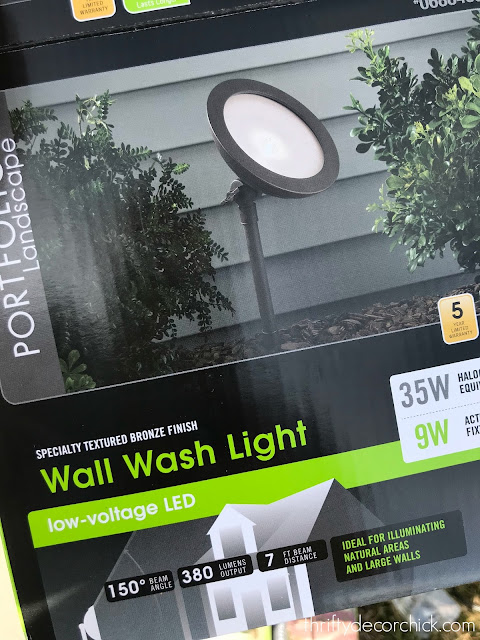
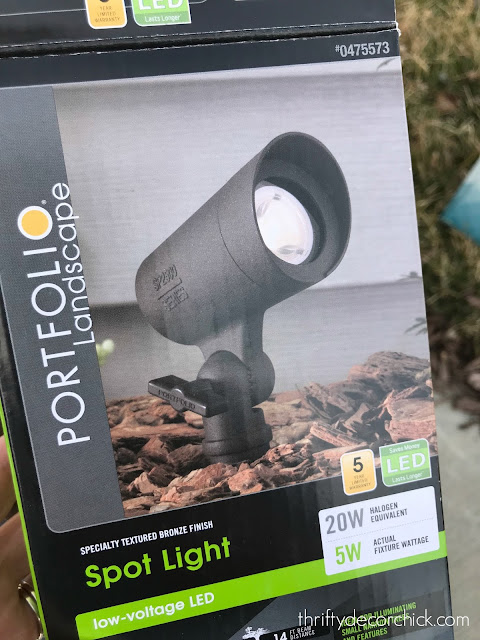
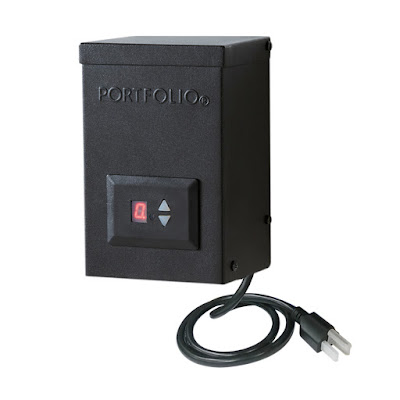
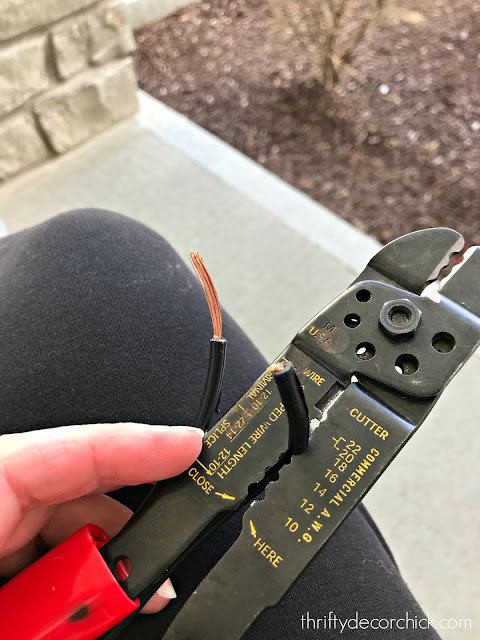

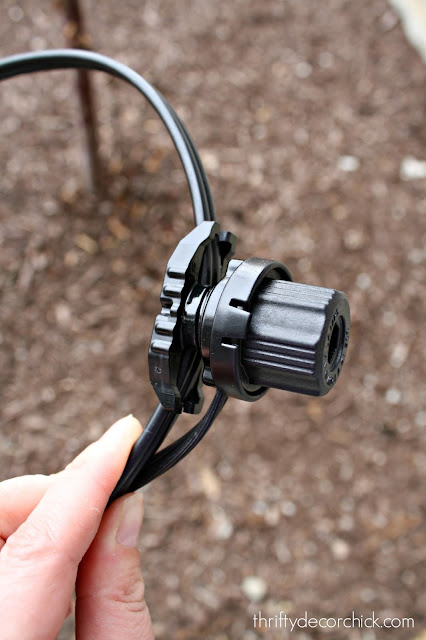
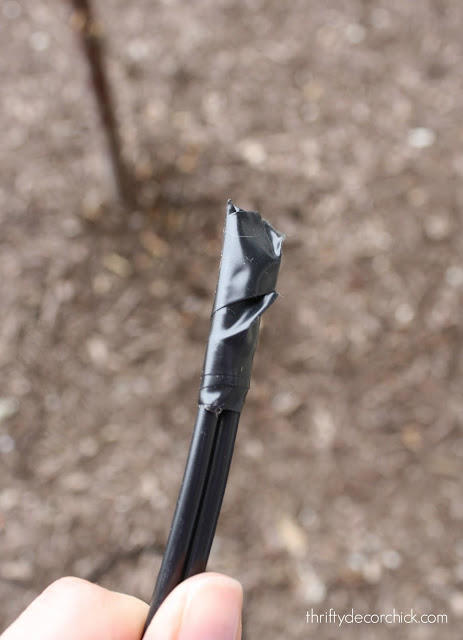
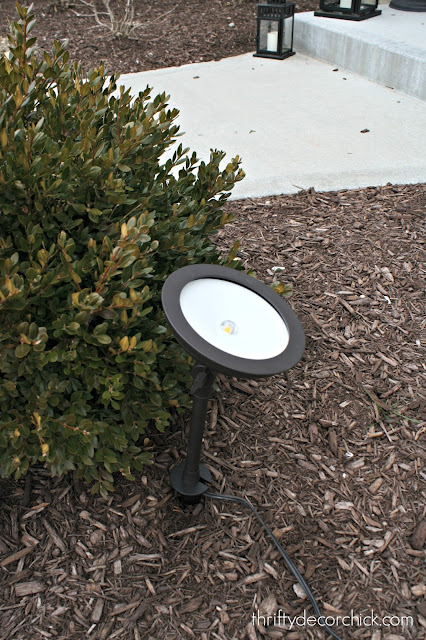
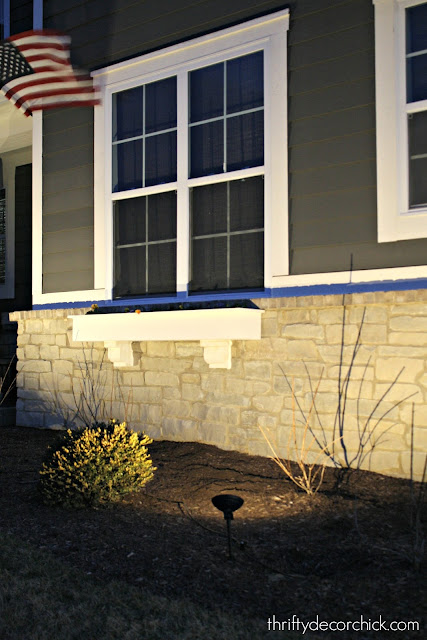
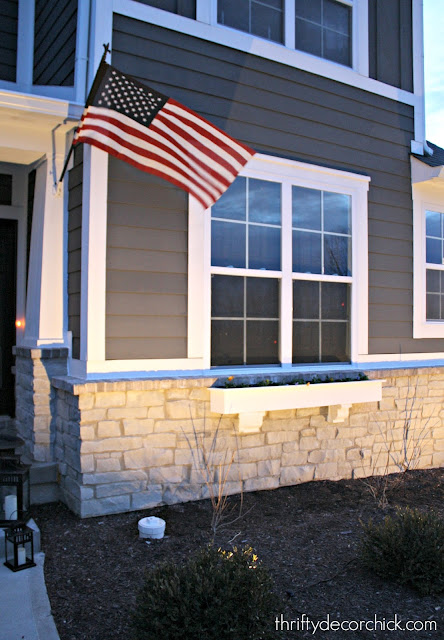
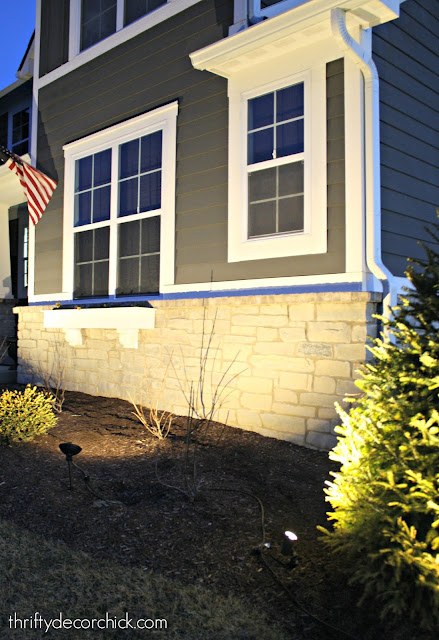
Comments
Post a Comment